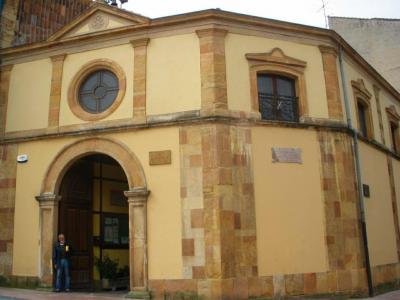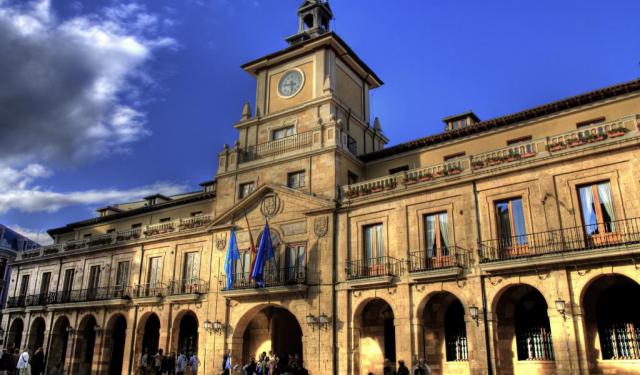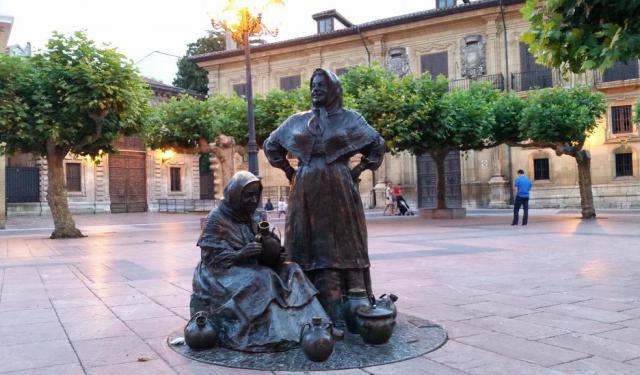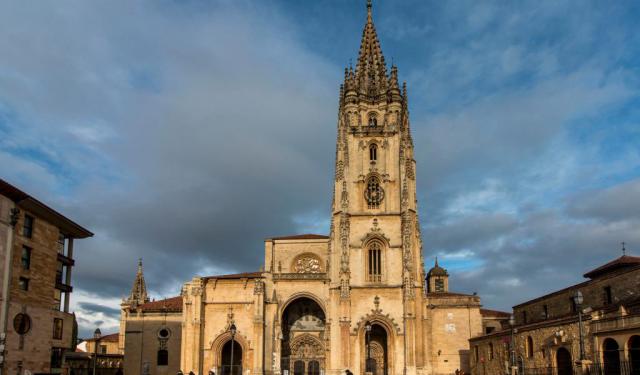Capilla de la Balesquida (Balesquida Chapel), Oviedo
The Balesquida Chapel is a charming urban chapel steeped in history. Though modest in size, its story stretches back centuries-it was originally founded in 1232 by Doña Velasquita Giráldez, a noblewoman widely revered in Oviedo as “Lady Balesquida” for her generous donations that included a hospital for pilgrims and support for local citizens. The chapel derives its name from both her and the Tailors’ Brotherhood she supported.
The present Baroque-style structure dates from 1725, with major reconstructions in 1876 and 1952. Its exterior is unassuming but elegant, featuring a pale yellow façade accented by warm stone trim and a pair of scissors symbol carved into the corner balcony-a nod to its long association with the tailors’ guild. Accessible through a small paved atrium and arched doorway, the chapel’s entrance invites passersby to step into a peaceful sacred space.
Inside, the chapel houses three richly decorated altarpieces from the 17th and 18th centuries. The central altar displays a wooden statue of the Virgin of Hope-a Gothic-style image from the 18th century adorned with votive garments donated by devotees, and crowned by a relief of the Holy Spirit. Side altars honor Saint Jude Thaddeus and Saint Bernard of Clairvaux, each framed by intricately carved columns and polychrome wood sculpture.
Also inside are two dramatic paintings by Oviedo-born artist Francisco Reiter, depicting key events in the life of Saint Bernard: his appointment as Abbot of Clairvaux, and the Virgin Mary alongside saints interceding on his behalf. A Gothic-era sculpture of the Virgin and Child, dating to the 13th century, is prominently displayed within the presbytery-one of the oldest artworks preserved in the chapel.
The present Baroque-style structure dates from 1725, with major reconstructions in 1876 and 1952. Its exterior is unassuming but elegant, featuring a pale yellow façade accented by warm stone trim and a pair of scissors symbol carved into the corner balcony-a nod to its long association with the tailors’ guild. Accessible through a small paved atrium and arched doorway, the chapel’s entrance invites passersby to step into a peaceful sacred space.
Inside, the chapel houses three richly decorated altarpieces from the 17th and 18th centuries. The central altar displays a wooden statue of the Virgin of Hope-a Gothic-style image from the 18th century adorned with votive garments donated by devotees, and crowned by a relief of the Holy Spirit. Side altars honor Saint Jude Thaddeus and Saint Bernard of Clairvaux, each framed by intricately carved columns and polychrome wood sculpture.
Also inside are two dramatic paintings by Oviedo-born artist Francisco Reiter, depicting key events in the life of Saint Bernard: his appointment as Abbot of Clairvaux, and the Virgin Mary alongside saints interceding on his behalf. A Gothic-era sculpture of the Virgin and Child, dating to the 13th century, is prominently displayed within the presbytery-one of the oldest artworks preserved in the chapel.
Want to visit this sight? Check out these Self-Guided Walking Tours in Oviedo. Alternatively, you can download the mobile app "GPSmyCity: Walks in 1K+ Cities" from Apple App Store or Google Play Store. The app turns your mobile device to a personal tour guide and it works offline, so no data plan is needed when traveling abroad.
Capilla de la Balesquida (Balesquida Chapel) on Map
Sight Name: Capilla de la Balesquida (Balesquida Chapel)
Sight Location: Oviedo, Spain (See walking tours in Oviedo)
Sight Type: Religious
Guide(s) Containing This Sight:
Sight Location: Oviedo, Spain (See walking tours in Oviedo)
Sight Type: Religious
Guide(s) Containing This Sight:
Walking Tours in Oviedo, Spain
Create Your Own Walk in Oviedo
Creating your own self-guided walk in Oviedo is easy and fun. Choose the city attractions that you want to see and a walk route map will be created just for you. You can even set your hotel as the start point of the walk.
Oviedo Historic Architecture
The north Spanish region of Asturias and particularly its capital city, Oviedo, have long been noted for their unique architecture. The medieval part of town, whose ancient walls are still largely intact, contains some truly priceless relics. Among them is a well called La Foncalada, a fascinating example of an effective hydraulic system, dating back to the first half of the 9th century, based on... view more
Tour Duration: 2 Hour(s)
Travel Distance: 2.7 Km or 1.7 Miles
Tour Duration: 2 Hour(s)
Travel Distance: 2.7 Km or 1.7 Miles
Oviedo Public Art Walking Tour
Public art adds a great deal of vibrancy and character to the cityscape of Oviedo, Spain, reflecting, among other things, its contemporary spirit. From the bustling Plaza Trascorrales to the serene Plaza Porlier De Oviedo, numerous sculptures have long become an integral part of the neighborhood, captivating passers-by in their numbers.
In Plaza Trascorrales, sculptures like The Fishwife and... view more
Tour Duration: 3 Hour(s)
Travel Distance: 3.0 Km or 1.9 Miles
In Plaza Trascorrales, sculptures like The Fishwife and... view more
Tour Duration: 3 Hour(s)
Travel Distance: 3.0 Km or 1.9 Miles
Oviedo Introduction Walking Tour
The Kingdom of Asturias began in 720, with the Visigothic revolt against Muslim rule led by the nobleman Pelagius. At that time, the city of Oviedo did not exist. Two monks, Maximo and Fromestano, founded the city in 761. They built a small church for Saint Vincent on a bare hillside, and from this seed, Oviedo grew.
After Pelagius died in 737, King Alfonso I founded a dynasty in Oviedo that... view more
Tour Duration: 1 Hour(s)
Travel Distance: 1.8 Km or 1.1 Miles
After Pelagius died in 737, King Alfonso I founded a dynasty in Oviedo that... view more
Tour Duration: 1 Hour(s)
Travel Distance: 1.8 Km or 1.1 Miles






